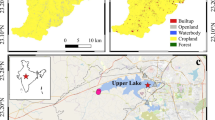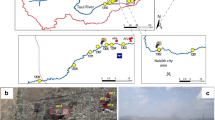Abstract
Metal loads to sediments of Lake Simcoe were partitioned into three components, which were attributable to natural background, accelerated erosion, and point + atmospheric sources. These loads were calculated over time using metal concentration profiles together with pre-settlement sedimentation rates based on sonar and time-variable sedimentation rates based on 210Po profiles in cores. Concentrations of metals significantly higher than pre-settlement concentrations were observed in all cores in the case of Pb, back to 80 yr BP on average, and in at least 75% of cores, back to 60 yr BP for Cd and Zn and 30 to 45 yr BP for Cu, Ni, and Cr. Total metal loads increased 3 × for Cu and Ni, 4 × for Zn and Cr, 11 × for Cd and nearly 20 × for Ph from pre-1800 to 0 to 10 yr BP. At present about 90% of the anthropogenic loads of Pb and Cd, and 60 to 70% of the anthropogenic Cu, Ni, Zn, and Cr, are from point + atmospheric sources, the balance being from increased erosion. The direct atmospheric input of Cd is relatively high, approximately 77% of point + atmospheric inputs, while inputs of Cr and Ni are low at 1% and 9%, and inputs of Cu, Zn, and Pb are intermediate at 20 to 40% of point + atmospheric inputs. Two significant findings on spatial distribution of metals were the large increases in metal loads to Cook Bay following the drainage of 33 km2 of marshes for agricultural use and the widespread dispersal of Cr from point source(s) in Kempenfelt Bay.
Similar content being viewed by others
References
Eakins, J. D. and Morrison, R. T.: 1978, Int. J. Applied Radiation and Isotopes 29, 531.
Edgington, D. N. and Robbins, J. A.: 1976, Environ. Sci. Technol. 10, 266.
Evans, R. D. and Dillon, P. J.: 1982, Hydrobiologia 91, 131.
Evans, R. D. and Rigler, F. H.: 1980, Environ. Sci. Technol. 14, 216.
Evans, D. O. and Waring, P.: 1987, Can. J. Fish Aquat. Sci. 44 (Suppl. 2), 182.
Galloway, J. N. and Likens, G. E.: 1979, Limnol. Oceanogr. 24, 427.
International Joint Commission: 1978, Environmental Strategy for the Great Lakes System, Report of the Pollution from Land Use Reference Group, IJC, Windsor, Ontario, 173 pp.
Johnson, M. G.: 1983, unpublished data.
Johnson, M. G.: 1987, Can. J. Fish. Aquat. Sci. 44, 3.
Johnson, M. G., Culp, L.., and George, S. E.: 1986, J. Fish. Aquat. Sci. 43, 754.
Johnson, M. G. and Nicholls, K. H.: 1988, J. Great Lakes Res. (in press).
Karrow, P. F., Anderson, T. W., Clarke, A. H., Delorme, L. D., and Sreenivasa, M. R.: 1975, Quarternary Research 5, 49.
Kemp, A. L. W. and Thomas, R. L.: 1976, Water, Air, and Soil Pollut. 5, 469.
Kemp, A. L. W., Williams, J. D. H., Thomas, R. L., and Gregory, M. L.: 1978, Water, Air, and Soil Pollut. 10,381.
MacCrimmon, H. R. and Skobe, E.: 1970, The Fisheries of Lake Simcoe, Department of Lands and Forests, Province of Ontario, 140 pp.
Nicholls, K. H.: 1976, Ecol. Monogr. 46, 179.
Nicholls, K. H., Forbes, F. M., Shaw, R., Humber, J., and Nakamoto, L.: 1985, J. Great Lakes Res. 11, 3.
Nriagu, J. O., Kemp, A. L. W., Wong, H. R. T., and Harper, N.: 1979, Geochem. Cosmochim. Acta. 43, 247.
Nriagu, J. O., Wong, H. K. T., and Snodgrass, W. J.: 1983, J. Great Lakes Res. 9, 365.
Ontario Ministry of the Environment: 1975, Lake Simcoe Basin, A Water Quality and Use Study, OME, Province of Ontario, Toronto, 143 pp.
Ontario Ministry of the Environment: 1982, Water Quality Characteristics of Lake Simcoe, OME, Province of Ontario, Toronto, 97 pp.
Ontario Ministry of the Environment: 1983, Precipitation Concentration and Wet Deposition Fields of Pollutants in Ontario, September 1980 to December 1981, Acid Precipitation in Ontario Study, OME, Province of Ontario, Toronto, 79 pp.
Ontario Ministry of the Environment: 1984, Precipitation Concentration and Wet Deposition Fields of Pollutants in Ontario, 1982, OME, Province of Ontario, Toronto, 68 pp.
Robbins, J. A.: 1980, Sediments of Southern Lake Huron: Elemental Composition and Accumulation Rates, EPA Publ. 600/3-80-080, 310 pp.
Sly, P. G. and Prior, J. W.: 1984, Can. J. Earth Sci. 21, 802.
Snedecor, G. W.: 1956, Statistical Methods Applied to Experiments in Agriculture and Biology, Iowa State College Press, Ames, Iowa, 534 pp.
Walters, L. J., Wolery, T. J., and Myser, R. D.: 1974, ‘Occurrence of As, Cd, Co, Cr, Cu, Fe, Hg, Ni, Sb and Zn in Lake Eric Sediments’, Conference Great Lakes Research 17, 219–234.
Wilson, J. P.: 1986, ‘The Use of Statistical Models to Document Environmental Change in the Lake Simcoe Basin’, Ph.D. Thesis, University of Toronto, 361 pp.
Author information
Authors and Affiliations
Rights and permissions
About this article
Cite this article
Johnson, M.G., Nicholls, K.H. Temporal and spatial trends in metal loads to sediments of Lake Simcoe, Ontario. Water Air Soil Pollut 39, 337–354 (1988). https://doi.org/10.1007/BF00279479
Received:
Revised:
Issue Date:
DOI: https://doi.org/10.1007/BF00279479




